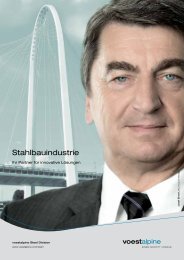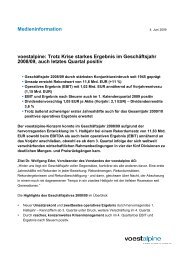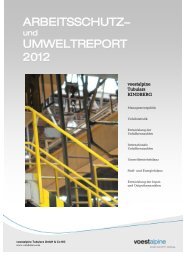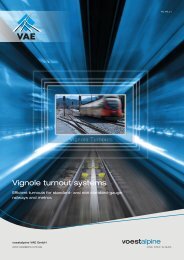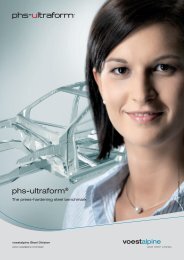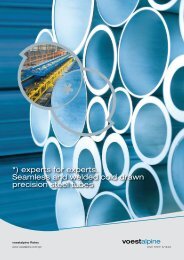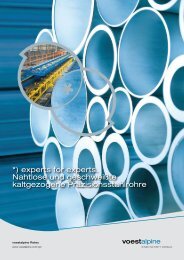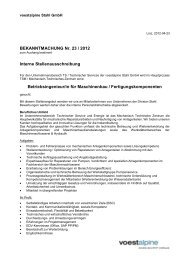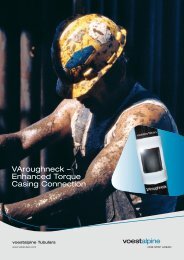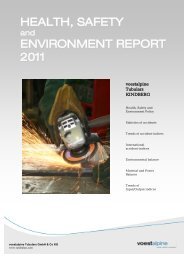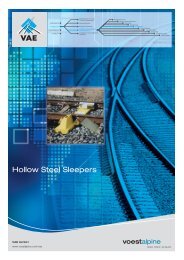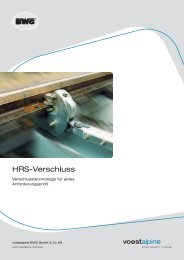History of the voestalpine group (1.37 MB)
History of the voestalpine group (1.37 MB)
History of the voestalpine group (1.37 MB)
You also want an ePaper? Increase the reach of your titles
YUMPU automatically turns print PDFs into web optimized ePapers that Google loves.
<strong>History</strong> <strong>of</strong> <strong>the</strong> <strong>voestalpine</strong> Group<br />
<strong>voestalpine</strong> AG<br />
www.<strong>voestalpine</strong>.com
The Group from 1938 up to <strong>the</strong> Present<br />
�<br />
�<br />
�<br />
�<br />
�<br />
�<br />
1938-1945: The Linz Site <strong>of</strong> Reichswerke AG „Hermann Göring“ Berlin<br />
1945-1973: VÖEST<br />
1973-1987: VOEST-ALPINE AG<br />
1988-1995: VOEST-ALPINE STAHL AG up to <strong>the</strong> Beginning <strong>of</strong> Privatization<br />
1996-2001: Restructuring <strong>of</strong> <strong>the</strong> Group. From VOEST-ALPINE STAHL AG to<br />
<strong>voestalpine</strong> AG<br />
<strong>voestalpine</strong> from 2001 up to <strong>the</strong> Present<br />
<strong>voestalpine</strong> AG<br />
2 | 07.04.2011 | Corporate Communications, Documentation Center
�<br />
�<br />
�<br />
1938-1945: The Linz Site <strong>of</strong> Reichswerke AG<br />
„Hermann Göring“ Berlin<br />
Beginning with 1938 an iron and steelworks – a subsidiary <strong>of</strong> <strong>the</strong> Reichswerke founded in<br />
Berlin in 1937 – was established in Linz as part <strong>of</strong> <strong>the</strong> national-socialist war industry.<br />
The approximately 4,500 inhabitants <strong>of</strong> St. Peter/Zizlau, <strong>the</strong> site for <strong>the</strong> Hermann Göring<br />
works, were relocated to o<strong>the</strong>r parts <strong>of</strong> <strong>the</strong> city.<br />
In 1939 Reichwerke Linz and Alpine Montangesellschaft merged to form Alpine Montan<br />
Aktiengesellschaft „Hermann Göring“ Linz.<br />
<strong>voestalpine</strong> AG<br />
3 | 07.04.2011 | Corporate Communications, Documentation Center<br />
Sou<strong>the</strong>rn Harbor Side towards Blast Furnaces
�<br />
�<br />
�<br />
1938-1945: The Linz Site <strong>of</strong> Reichswerke AG<br />
„Hermann Göring“ Berlin<br />
Hermann Göring works comprised at <strong>the</strong> Linz site five large companies, among <strong>the</strong>m<br />
Eisenwerke Oberdonau, which was given highest priority, because it was an armaments<br />
factory.<br />
From 1941 onward <strong>the</strong> complex <strong>of</strong> companies in Linz successively began production.<br />
It would not have been possible to build <strong>the</strong> plants in Linz and to produce armaments<br />
without <strong>the</strong> use <strong>of</strong> foreign labor. In summer 1938 foreign civilian workers arrived. Later,<br />
from 1940/1941, forced laborers, prisoners <strong>of</strong> war and, beginning at <strong>the</strong> end <strong>of</strong> 1942, also<br />
concentration camp prisoners were used.<br />
<strong>voestalpine</strong> AG<br />
4 | 07.04.2011 | Corporate Communications, Documentation Center
�<br />
�<br />
�<br />
1938-1945: The Linz Site <strong>of</strong> Reichswerke AG<br />
„Hermann Göring“ Berlin<br />
In <strong>the</strong> summer <strong>of</strong> 1944 allied bombing<br />
attacks on Linz and <strong>the</strong> site began.<br />
The number <strong>of</strong> laborers reached its<br />
highest point in 1944. At that time <strong>the</strong><br />
percentage <strong>of</strong> foreign laborers (not<br />
counting prisoners <strong>of</strong> war and<br />
concentration camp prisoners) averaged<br />
two-thirds. In some particular sections <strong>of</strong><br />
production <strong>the</strong> figure was more than 90<br />
percent.<br />
Somewhat more than 10 percent <strong>of</strong> <strong>the</strong><br />
foreign workers at <strong>the</strong> Linz site were<br />
women.<br />
<strong>voestalpine</strong> AG<br />
5 | 07.04.2011 | Corporate Communications, Documentation Center<br />
Laborers for Production, Eisenwerke<br />
Oberdonau, January 1941 to May 1942
�<br />
�<br />
�<br />
�<br />
�<br />
<strong>voestalpine</strong> AG<br />
6 | 07.04.2011 | Corporate Communications, Documentation Center<br />
VÖEST 1945-1973<br />
May 5, 1945 – US troops reached Linz. The plants in <strong>the</strong> city were confiscated as German<br />
assets.<br />
In July, respectively, in October <strong>the</strong>y were renamed „Vereinigte Österreichische Eisen-<br />
und Stahlwerke AG“ (United Austrian Iron and Steelworks AG) or VÖEST. In addition, <strong>the</strong>y<br />
were separated from Alpine Montan AG.<br />
Vehement differences <strong>of</strong> opinion on <strong>the</strong> question <strong>of</strong> whe<strong>the</strong>r <strong>the</strong> plants should continue in<br />
existence. The decision to continue operating <strong>the</strong> plants in Linz also led to a significant<br />
alteration <strong>of</strong> <strong>the</strong> regional economic structure.<br />
Summer 1946 – The commanding American <strong>of</strong>ficer, General Mark W. Clark, turned<br />
VÖEST over to <strong>the</strong> Republic <strong>of</strong> Austria in trust. Ten days later VÖEST was nationalized on<br />
<strong>the</strong> basis <strong>of</strong> <strong>the</strong> First Nationalization Act.<br />
Iron and Steel Plan 1948 – The production <strong>of</strong> commercial sheet steel was concentrated in<br />
Linz. The same year saw <strong>the</strong> beginning <strong>of</strong> an expansion program with foreign capital made<br />
available through <strong>the</strong> Marshall Plan <strong>of</strong> <strong>the</strong> USA.
�<br />
�<br />
�<br />
The success story <strong>of</strong> VÖEST began with<br />
<strong>the</strong> managing <strong>of</strong> <strong>the</strong> post-war chaos and<br />
<strong>the</strong> reconstruction.<br />
An important step was <strong>the</strong> development <strong>of</strong><br />
<strong>the</strong> LD process. After a long period <strong>of</strong><br />
preliminary work in Austria and o<strong>the</strong>r<br />
countries, scientists in Linz made <strong>the</strong><br />
breakthrough. The world‘s first LD<br />
steelmaking plant was constructed in Linz.<br />
From 1952 onward <strong>the</strong> LD process<br />
revolutionized steel production.<br />
Conclusion <strong>of</strong> <strong>the</strong> State Treaty in 1955.<br />
VÖEST took over management <strong>of</strong> <strong>the</strong><br />
Krems steelworks.<br />
<strong>voestalpine</strong> AG<br />
7 | 07.04.2011 | Corporate Communications, Documentation Center<br />
VÖEST 1945-1973<br />
LD Steel Making Plant 1
�<br />
�<br />
�<br />
<strong>voestalpine</strong> AG<br />
8 | 07.04.2011 | Corporate Communications, Documentation Center<br />
VÖEST 1945-1973<br />
In 1957 VÖEST began constructing seagoing vessels in order to prove that plates <strong>of</strong> LD<br />
steel were fully suitable for shipbuilding and also to achieve a degree <strong>of</strong> stabilization in <strong>the</strong><br />
shipping costs <strong>of</strong> VÖEST‘s substantial overseas acquisitions <strong>of</strong> raw materials. In total, four<br />
seagoing freighters were launched by 1967 (Linzertor, Wienertor, Kremsertor und<br />
Buntentor).<br />
In 1958 entry into <strong>the</strong> construction <strong>of</strong> industrial plants on an international level. In<br />
cooperation with <strong>the</strong> Fried. Krupp company in Essen, Germany, VÖEST began<br />
construction in Rourkela (India) <strong>of</strong> <strong>the</strong> first steelmaking plant outside <strong>of</strong> Austria.<br />
In 1959 <strong>the</strong> public management <strong>of</strong> VÖEST, which had been in effect since <strong>the</strong> end <strong>of</strong> <strong>the</strong><br />
war, was replaced by customary organizational bodies (Management Board, Supervisory<br />
Board and Annual General Meeting).
�<br />
�<br />
�<br />
�<br />
In <strong>the</strong> 1960s VÖEST became, by Austrian<br />
standards, a huge and multi-faceted<br />
conglomerate.<br />
In 1963 <strong>the</strong> reorganization <strong>of</strong> VÖEST<br />
began.<br />
Beginning with <strong>the</strong> mid-1960s a special<br />
investment program aimed at <strong>the</strong><br />
modernization <strong>of</strong> finishing operations<br />
(among o<strong>the</strong>r things <strong>the</strong> first slab<br />
continuous caster at LD Steelmaking Plant<br />
2).<br />
In 1973 VÖEST, Linz, merged with <strong>the</strong><br />
operations <strong>of</strong> Österreichisch-Alpine<br />
Montangesellschaft, Wien, to form<br />
VÖEST-ALPINE AG.<br />
<strong>voestalpine</strong> AG<br />
9 | 07.04.2011 | Corporate Communications, Documentation Center<br />
VÖEST 1945-1973<br />
Assembly works on <strong>the</strong> steel structure <strong>of</strong> Europabrücke (1962)
�<br />
�<br />
�<br />
<strong>voestalpine</strong> AG<br />
VOEST-ALPINE AG 1973-1987<br />
The effects <strong>of</strong> <strong>the</strong> merger coincided with<br />
<strong>the</strong> international economic crisis. From<br />
1975 <strong>the</strong> repercussions also reached<br />
Austria.<br />
Until 1976 various o<strong>the</strong>r companies were<br />
consolidated to form new companies and<br />
were integrated into VÖEST-ALPINE AG<br />
(among o<strong>the</strong>rs <strong>the</strong> companies <strong>of</strong> <strong>the</strong><br />
Edelstahlindustrie (Böhler, Schoeller-<br />
Bleckmann and Steirischen<br />
Gussstahlwerke), which were<br />
consolidated to form Vereinigte<br />
Edelstahlwerke AG (VEW).<br />
1977 – A new form <strong>of</strong> organization was<br />
instituted. The <strong>group</strong> was broken down<br />
into four business segments: steelworks,<br />
processing, finished products and<br />
industrial plant construction.<br />
10 | 07.04.2011 | Corporate Communications, Documentation Center<br />
Commissioning <strong>of</strong> Blast Furnace A (1977)
�<br />
�<br />
�<br />
�<br />
<strong>voestalpine</strong> AG<br />
VOEST-ALPINE AG 1973-1987<br />
In 1980 a comprehensive diversification strategy was initiated.<br />
Since 1981 VOEST-ALPINE Group had been operating at a big deficit.<br />
1985 – Crash <strong>of</strong> VOEST-ALPINE<br />
Constant exertion <strong>of</strong> political influence, <strong>the</strong> misuse <strong>of</strong> <strong>the</strong> company as a national labor<br />
pool, changes in international framework conditions, <strong>the</strong> erosion <strong>of</strong> individual companies,<br />
failures in diversification, in foreign projects and in finished products as well as enormous<br />
losses <strong>of</strong> <strong>the</strong> trading subsidiary Intertrading led to <strong>the</strong> crash<br />
which set in motion a far-reaching restructuring process for Austrian industry. The<br />
conglomerate was broken-up.<br />
11 | 07.04.2011 | Corporate Communications, Documentation Center
�<br />
�<br />
�<br />
<strong>voestalpine</strong> AG<br />
VOEST-ALPINE AG 1973-1987<br />
1986 – VOEST-ALPINE NEW: A new organizational structure was developed, a<br />
streamlining program was agreed upon and an investment program was authorized.<br />
The Stahlstiftung (Steel Foundation) was founded in 1987 to provide support for<br />
employees who had lost <strong>the</strong>ir jobs.<br />
1987 – The Group approved an investment package promoting environmental protection.<br />
12 | 07.04.2011 | Corporate Communications, Documentation Center
1988-1995: VOEST-ALPINE STAHL AG up to <strong>the</strong><br />
Beginning <strong>of</strong> Privatization<br />
�<br />
�<br />
1988 – A fundamental reorganization <strong>of</strong><br />
<strong>the</strong> ÖIAG Group led to <strong>the</strong> formation <strong>of</strong> six<br />
holding companies, one <strong>of</strong> <strong>the</strong>m was<br />
VOEST-ALPINE STAHL AG.<br />
It encompassed six controlling companies:<br />
VOEST-ALPINE Stahl Linz GmbH,<br />
VOEST-ALPINE Stahl Donawitz GmbH,<br />
Böhler GmbH Kapfenberg, Böhler AG<br />
Düsseldorf, VOEST-ALPINE Stahlhandel<br />
AG and VOEST- ALPINE Rohst<strong>of</strong>fhandel<br />
GmbH.<br />
<strong>voestalpine</strong> AG<br />
13 | 07.04.2011 | Corporate Communications, Documentation Center<br />
Coil Coating Plant (COLOFER)
1988-1995: VOEST-ALPINE STAHL AG up to <strong>the</strong><br />
Beginning <strong>of</strong> Privatization<br />
�<br />
�<br />
�<br />
In 1989 <strong>the</strong> most important holding companies <strong>of</strong> ÖIAG, among <strong>the</strong>m VOEST-ALPINE<br />
STAHL AG, were placed under Industrie- und Beteiligungsverwaltungs-GesmbH (IBVG), a<br />
wholly owned subsidiary <strong>of</strong> ÖIAG. In 1990 IBVG was converted into Austrian Industries<br />
AG (AI).<br />
1990 – Acquisition <strong>of</strong> <strong>the</strong> Swedish Uddeholm Group, which in <strong>the</strong> following year merged<br />
with <strong>the</strong> companies <strong>of</strong> <strong>the</strong> Böhler Group to form Böhler-Uddeholm.<br />
In 1993 AI was dissolved. Three <strong>group</strong>s were created from AI with <strong>the</strong> goal <strong>of</strong> privatization:<br />
VA Technologie AG, Böhler-Uddeholm AG and VOEST-ALPINE STAHL AG.<br />
<strong>voestalpine</strong> AG<br />
14 | 07.04.2011 | Corporate Communications, Documentation Center
1988-1995: VOEST-ALPINE STAHL AG up to <strong>the</strong><br />
Beginning <strong>of</strong> Privatization<br />
�<br />
�<br />
In order to optimize <strong>the</strong> portfolio, in 1994<br />
business segments that ei<strong>the</strong>r lay outside<br />
core competences or possessed too little<br />
synergy potential for <strong>the</strong> <strong>group</strong> were<br />
divested (e.g., VOEST-ALPINE Stahl<br />
Judenburg GmbH).<br />
In 1995, one year earlier than originally<br />
planned, VOEST-ALPINE STAHL AG<br />
went public and got a new ownership<br />
structure.<br />
<strong>voestalpine</strong> AG<br />
15 | 07.04.2011 | Corporate Communications, Documentation Center<br />
Dedusting system for Sinter Belt 5 (1993)
�<br />
�<br />
�<br />
1996-2001: Restructuring <strong>of</strong> <strong>the</strong> Group. From<br />
VOEST-ALPINE STAHL AG to <strong>voestalpine</strong> AG<br />
A number <strong>of</strong> acquisitions were made<br />
during <strong>the</strong>se years (e.g., <strong>the</strong> British<br />
company METSEC plc., <strong>the</strong> Dutch<br />
Polynorm N.V., <strong>the</strong> German TSTG<br />
(Thyssen Schienen Technik GmbH).<br />
Up to 1998 <strong>the</strong> product portfolio <strong>of</strong> <strong>the</strong><br />
Group was fur<strong>the</strong>r enhanced through an<br />
extensive expansion program and <strong>the</strong><br />
processing percentage was increased<br />
even fur<strong>the</strong>r.<br />
In mid-1997 a facility to manufacture<br />
laser-welded blanks (sheet steel blanks<br />
for <strong>the</strong> automotive industry) began<br />
operation after a record construction time<br />
<strong>of</strong> only one year.<br />
<strong>voestalpine</strong> AG<br />
16 | 07.04.2011 | Corporate Communications, Documentation Center<br />
Roller leveler and rail cooling bed (120 m) in Donawitz
�<br />
�<br />
�<br />
�<br />
�<br />
1996-2001: Restructuring <strong>of</strong> <strong>the</strong> Group. From<br />
VOEST-ALPINE STAHL AG to <strong>voestalpine</strong> AG<br />
In 1997 VOEST-ALPINE SCHIENEN GmbH & Co KG in Donawitz started a remodeling<br />
and expansion program to ensure <strong>the</strong> continuation <strong>of</strong> ist technological leadership.<br />
In 1998 at VOEST-ALPINE STAHL LINZ GmbH <strong>the</strong> continuous annealing line in Cold<br />
Rolling mill 2 – a milestone in continuous annealing technology in Europe – started<br />
production, followed in 1999 by Secondary Dedusting 2 and in 2000 by a new vacuum<br />
system in LD Steelmaking Plant 3.<br />
In 2001 <strong>voestalpine</strong> Grobblech GmbH achieved an important success with <strong>the</strong> product<br />
launch <strong>of</strong> its innovative sour service plates for tubes.<br />
The Donawitz site received a modernization boost. In 2000 this included <strong>the</strong> conversion <strong>of</strong><br />
<strong>the</strong> LD steel mill into a LD compact steelmaking plant incorporating state-<strong>of</strong>-<strong>the</strong>-art<br />
technology and in 2001, <strong>the</strong> decision to invest in <strong>the</strong> modernization and expansion <strong>of</strong> rail<br />
production.<br />
Beginning in 2001 <strong>the</strong> employee shareholding scheme was implemented on <strong>the</strong> <strong>group</strong><br />
level. Employees at <strong>the</strong> Austrian sites held approximately 4 percent <strong>of</strong> <strong>the</strong> shares <strong>of</strong> <strong>the</strong>ir<br />
company.<br />
<strong>voestalpine</strong> AG<br />
17 | 07.04.2011 | Corporate Communications, Documentation Center
�<br />
�<br />
�<br />
�<br />
1996-2001: Restructuring <strong>of</strong> <strong>the</strong> Group. From<br />
VOEST-ALPINE STAHL AG to <strong>voestalpine</strong> AG<br />
2001 – Alteration <strong>of</strong> <strong>the</strong> corporate structure. Instead <strong>of</strong> <strong>the</strong> typical steel structure <strong>of</strong> flat<br />
products and long products a breakdown into <strong>the</strong> divisions <strong>of</strong> Steel, motion (from 2005<br />
onward Automotive), Railway Systems and Pr<strong>of</strong>ilform was introduced.<br />
„More out <strong>of</strong> steel“ – Constant extension <strong>of</strong> <strong>the</strong> value chain.<br />
High-tech-company and market niche provider – Clear orientation towards processing,<br />
upgrading, manufacturing <strong>of</strong> components and provider <strong>of</strong> specific and complete solutions.<br />
At this time, <strong>the</strong> name <strong>of</strong> <strong>the</strong> Group was changed to <strong>voestalpine</strong> AG and pursued an<br />
umbrella brand strategy under <strong>the</strong> brand <strong>voestalpine</strong>.<br />
<strong>voestalpine</strong> AG<br />
18 | 07.04.2011 | Corporate Communications, Documentation Center
�<br />
�<br />
<strong>voestalpine</strong> AG<br />
<strong>voestalpine</strong> from 2002 up to <strong>the</strong> Present<br />
In 2002 <strong>the</strong> 45.3 percent share <strong>of</strong> VAE<br />
held by Vossloh AG were acquired. With<br />
that and <strong>the</strong> acquisition <strong>of</strong> <strong>the</strong> remaining<br />
9.4 percent free-float shares in January<br />
2003 <strong>voestalpine</strong> Bahnsysteme GmbH<br />
became <strong>the</strong> sole owner <strong>of</strong> <strong>the</strong> world‘s<br />
leading manufacturer <strong>of</strong> turnouts.<br />
2002 – Beginning <strong>of</strong> <strong>the</strong> Investment<br />
program „Linz 2010“: Relining and<br />
expansion <strong>of</strong> Blast Furnace A. Associated<br />
facilities were aligned with <strong>the</strong> new<br />
capacity (among o<strong>the</strong>rs, <strong>the</strong> sintering<br />
plant, <strong>the</strong> power plant, LD Steelmaking<br />
Plant 3, <strong>the</strong> rolling mills and <strong>the</strong> coil<br />
coating lines). This project was originally<br />
scheduled for <strong>the</strong> year 2010 and entered<br />
its last stage in 2007 – and <strong>the</strong>refore<br />
distinctly earlier than planned.<br />
19 | 07.04.2011 | Corporate Communications, Documentation Center<br />
Plastic Injection Tower at Blast Furnace A in Linz
�<br />
�<br />
�<br />
�<br />
�<br />
<strong>voestalpine</strong> AG<br />
<strong>voestalpine</strong> from 2002 up to <strong>the</strong> Present<br />
Follow-up-project „L 6“, in which „L“ stands for <strong>the</strong> Linz site and „6“ for <strong>the</strong> increase <strong>of</strong> <strong>the</strong><br />
crude steel production <strong>of</strong> approximately 5.4 million tons to more than 6 million tons per<br />
year.<br />
In 2003 <strong>the</strong> employee shareholding scheme <strong>of</strong> <strong>voestalpine</strong> AG increased to around 10.5<br />
percent.<br />
In 2003 <strong>voestalpine</strong> was fully privatized and a convertible bond for <strong>the</strong> remaining 15% <strong>of</strong><br />
government-owned shares was issued.<br />
The bond was converted on August 31, 2005, which meant that <strong>voestalpine</strong> was <strong>the</strong>n fully<br />
in private ownership.<br />
The Group‘s international presence was fur<strong>the</strong>r enhanced through expansion up to 2008.<br />
Among o<strong>the</strong>rs Eastern Europe, India, China, Brasil, Great Britain.<br />
20 | 07.04.2011 | Corporate Communications, Documentation Center
�<br />
�<br />
�<br />
<strong>voestalpine</strong> AG<br />
<strong>voestalpine</strong> from 2002 up to <strong>the</strong> Present<br />
2007/2008 - 100 percent acquisition <strong>of</strong> <strong>the</strong><br />
BÖHLER-UDDEHOLM-Group and<br />
integration as <strong>the</strong> Special Steel Division.<br />
A unique economic success story so far<br />
with constant new all-time highs regarding<br />
turnover, results and workforce.<br />
R&D and Environment – According to EU<br />
statistics <strong>voestalpine</strong> has been <strong>the</strong> most<br />
research-intensive industrial company.<br />
Numerous environment and safety<br />
awards.<br />
21 | 07.04.2011 | Corporate Communications, Documentation Center<br />
BÖHLER-UDDEHOLM: Kapfenberg site, old works
�<br />
�<br />
�<br />
�<br />
�<br />
�<br />
<strong>voestalpine</strong> AG<br />
<strong>voestalpine</strong> from 2002 up to <strong>the</strong> Present<br />
In fall 2008 <strong>the</strong> economic downswing due to <strong>the</strong> world-wide banking and financial crisis<br />
also reached <strong>voestalpine</strong>. The demand started spiraling downward.<br />
The swiftly implemented crisis management <strong>of</strong> <strong>the</strong> Group reacted comprehensively to <strong>the</strong><br />
deterioriating situation and a cost-cutting and efficiency improvement program was<br />
implemented with <strong>the</strong> objective <strong>of</strong> achieving optimization across <strong>the</strong> entire <strong>group</strong>.<br />
The business year 2009/10 was characterized by <strong>the</strong> big economic crisis and was <strong>the</strong><br />
toughest and most difficult in decades.<br />
However, during <strong>the</strong> first nine months <strong>of</strong> <strong>the</strong> business year 2010/11 <strong>voestalpine</strong> Group<br />
was again able to achieve a very significant growth in turnover and results compared to<br />
<strong>the</strong> previous year.<br />
The employees currently hold approximately 13.3% <strong>of</strong> <strong>voestalpine</strong> AG‘s shares.<br />
At <strong>the</strong> end <strong>of</strong> 2010 <strong>voestalpine</strong> Group employs approximately 40,000 staff throughout <strong>the</strong><br />
world, <strong>the</strong>re<strong>of</strong> 53% at international locations.<br />
22 | 07.04.2011 | Corporate Communications, Documentation Center



